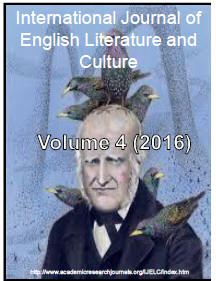|
International Journal of English
Literature and Culture
Vol. 4(2), pp. 35-40, February, 2016
ISSN: 2360-7831
DOI: 10.14662/IJELC2016.018
Review paper
Poetic Style of E.E. Cummings: Discerning Meaning through Language
Dr. Sukanya Saha
Asst. Prof. English, Dept. of English, Vidhyasagar Women’s College,
Chengalpet
Accepted 14 March 2016
Literature is
a form of self-expression. Writers from all over the world and ages have
been expressing themselves in different genres throughout. Each writer
exhibits his own style which is reflected in his choice of words,
structures or themes. Writer’s style becomes the hallmark of his
personality and he is recognised or stands apart from his contemporaries
or predecessors on the characteristic features of his works which are
essentially his own. The uniqueness with which he gives a form to his
literature earns him his worldwide reputation and thus sets up an
example or model for others. Needless to say this also gives birth to
perennial research and discussion.
E.E. Cummings was one such writer. His poetry has intrigued his reader
having a distinct treatment which he gives to his thoughts. Cummings
made a mark in the history of English literature. John Logan in Modern
American Poetry: Essays in Criticism called him "one of the greatest
lyric poets in our language."1 Stanley Edgar Hyman wrote in Standards: A
Chronicle of Books for Our Time: "Cummings has written at least a dozen
poems that seem to me matchless. Three are among the great love poems of
our time or any time."2 Malcolm Cowley admitted in the Yale Review that
Cummings "suffers from comparison with those [poets] who built on a
larger scale—Eliot, Aiken, Crane, Auden among others—but still he is
unsurpassed in his special field, one of the masters."3Jenny Penberthy
in the Dictionary of Literary Biography considers Cummings "Among the
most innovative of twentieth-century poets.” 4
E. E. Cummings experimented with multiple aspects of poetry and moulded
its language to create his own unique style. A Cummings poem typically
looks like words scattered on the page. Cummings formed his own words,
changed the existing English words and gave them a new meaning. His
deviation from the traditionally accepted poetic norms made him popular
with many readers as he stood out from his peers. "No one else," Randall
Jarrell claimed in his The Third Book of Criticism, "has ever made
avant-garde, experimental poems so attractive to the general and the
special reader5."
The following discussion is an attempt to view and highlight the
characteristic features of Cumming’s poetry. His style, for which he was
recognised, is reflected in his manner of presentation of innermost
feelings. His poetry is governed by passion and equally passionate he
appears when he fashions his poetry in an unprecedented manner. The
present article is an attempt to study some of the prominent features of
his poetry. The focus is on the language of Cummings, and the poetic
licences which he has enjoyed in expressing his thinking.
Key Words: E. E. Cummings, poetic experimentation, poetic style,
sentence structures, lexis
Cite
This Article As:
Dr. Saha S (2016). Poetic Style of E.E.
Cummings: Discerning Meaning through Language. Inter. J. Eng. Lit. Cult.
4(2): 35-40
FULL TEXT PDF
|
|
|
